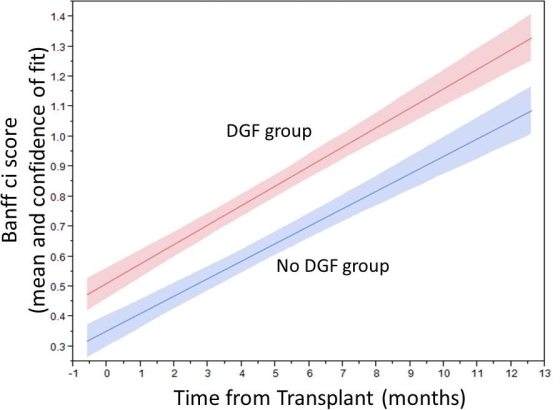Delayed Graft Function (DGF) Does Not Accelerate Progression of Fibrosis During the First Year After Deceased Donor Kidney Transplantation.
Mayo Clinic, Phoenix, AZ.
Meeting: 2016 American Transplant Congress
Abstract number: 273
Keywords: Fibrosis, Graft survival, Kidney transplantation, Protocol biopsy
Session Information
Session Name: Concurrent Session: Acute Kidney Injury and Recovery after Transplantation
Session Type: Concurrent Session
Date: Monday, June 13, 2016
Session Time: 4:30pm-6:00pm
 Presentation Time: 5:18pm-5:30pm
Presentation Time: 5:18pm-5:30pm
Location: Ballroom C
Background
Our aim was to study the impact of DGF on the progression of interstitial fibrosis during the first post-transplant year.
Methods
We included all patients who received a deceased donor kidney transplant at our center between July 2003 and April 2015. We excluded combined organ transplants and recipients who lost the allograft during the first 30 days (n=16). We defined DGF as a less than a 30% drop in creatinine from day 0 to 3 or the need for dialysis within 7 days. Surveillance biopsies (Bx) are done at reperfusion and at 1, 4 and 12 months post-transplant. We used a linear mixed model to analyze differences in the slope for the progression of fibrosis (mean of Banff ci score 0-3 as continuous variable) between 0 and 12 months and a logistic regression analysis to adjust for variables associated with graft fibrosis at 12 months. Continuous data is shown as mean±1 standard deviation.
Results
1054 patients were included in the study: 604 (57%) were in the DGF group and 450 in the control group. Recipient age (55.7±12.8) was not different between groups. The DGF group was more likely to be male, diabetic and on dialysis prior to transplant. Donor age was higher, more likely to be a DCD donor and had a higher KDPI score in the DGF group. 3-year death censored graft survival was 93.3% in the DGF group and 95.3% in the control group (p=0.18). The eGFR (by CKD-EPI) at 12 months was lower in the DGF group (56.8± 20.6 vs 61.2± 21.1 (p=0.004)). The cumulate rejection rate at 12 months was 16.6% in the DGF group and 17.6% in the control group (p=0.62). The RR of Banff ci>1 for the DGF group on the 12 month Bx (adjusted for time 0 ci and the donor KDPI) was 1.23 (95% CI 0.79-1.93, p=0.35).
The mean for the Banff ci score (0-3 as continuous variable) for biopsies done at reperfusion and at months 1, 3 and 12 months post-transplant were plotted. There was no significant difference in the slopes between the DGF and control group (p=0.549) (figure).

Conclusion
DGF after deceased donor kidney transplantation does not accelerate the progression of interstitial fibrosis during the first post-transplant year.
CITATION INFORMATION: Heilman R, Qaqish I, Smith M, Khamash H, Kaplan B, Reddy K. Delayed Graft Function (DGF) Does Not Accelerate Progression of Fibrosis During the First Year After Deceased Donor Kidney Transplantation. Am J Transplant. 2016;16 (suppl 3).
To cite this abstract in AMA style:
Heilman R, Qaqish I, Smith M, Khamash H, Kaplan B, Reddy K. Delayed Graft Function (DGF) Does Not Accelerate Progression of Fibrosis During the First Year After Deceased Donor Kidney Transplantation. [abstract]. Am J Transplant. 2016; 16 (suppl 3). https://atcmeetingabstracts.com/abstract/delayed-graft-function-dgf-does-not-accelerate-progression-of-fibrosis-during-the-first-year-after-deceased-donor-kidney-transplantation/. Accessed December 20, 2025.« Back to 2016 American Transplant Congress
